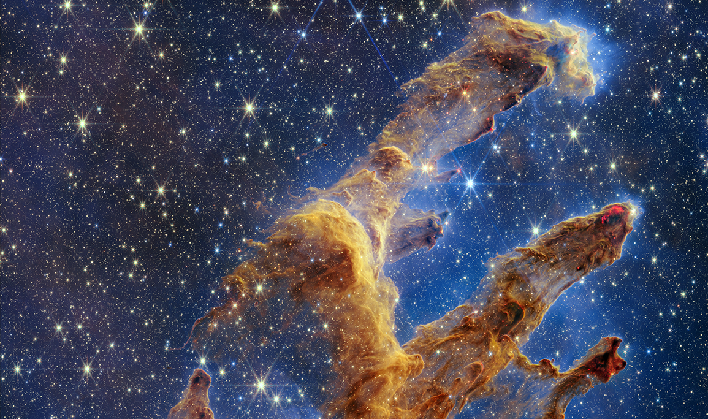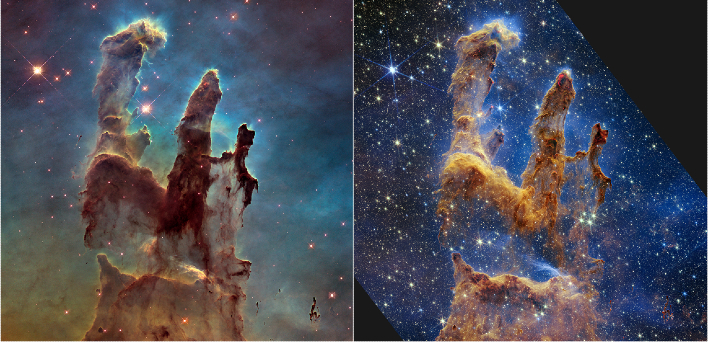JWST Captures Pillars Of Creation As Never Seen Before And It Will Take Your Breath Away
NASA's James Webb Space Telescope (JWST) has captured an awe-inspiring image of the iconic Pillars of Creation. The interstellar gas and dust that make up the incredible columns, are home to a plethora of newly forming stars.
The Pillars of Creation were first made famous by the Hubble Space Telescope in 1995. The color image provided by Hubble was created using three separate images taken in the light of emission from different types of atoms. Hubble captured its images of the columns with its Wide Field and Planetary Camera 2. Now, NASA's Webb telescope has turned its attention on the pillars in order to "revamp their models of star formation by identifying far more precise counts of newly formed stars, along with the quantities of gas and dust in the region."
The bright red orbs that ordinarily have diffraction spikes and lie outside one of the dusty pillars, are actually newly formed stars captured by Webb's Near-Infrared Camera (NIRCam). These new stars are formed as "knots with sufficient mass form within the pillars of gas and dust," and begin to collapse under their own gravity, and slowly heat up.
Due to young stars regularly shooting out supersonic jets that collide with clouds of material, wavy lines are created that appear to look like lava at the edges of some of the pillars. The red glow is derived from the energetic hydrogen molecules that are a product of jets and shocks. These young stars are estimated to be a mere few hundred thousand years old, according to NASA.
The Pillars of Creation have been captured by more than a few observatories, including Hubble and Webb. With each new advanced instrument, such as Webb, researchers, astronomers and scientists are gaining new details and data about the region. If you would like to download the full-resolution image taken by Webb, you can do so on NASA's website.
The Pillars of Creation were first made famous by the Hubble Space Telescope in 1995. The color image provided by Hubble was created using three separate images taken in the light of emission from different types of atoms. Hubble captured its images of the columns with its Wide Field and Planetary Camera 2. Now, NASA's Webb telescope has turned its attention on the pillars in order to "revamp their models of star formation by identifying far more precise counts of newly formed stars, along with the quantities of gas and dust in the region."
The bright red orbs that ordinarily have diffraction spikes and lie outside one of the dusty pillars, are actually newly formed stars captured by Webb's Near-Infrared Camera (NIRCam). These new stars are formed as "knots with sufficient mass form within the pillars of gas and dust," and begin to collapse under their own gravity, and slowly heat up.
Due to young stars regularly shooting out supersonic jets that collide with clouds of material, wavy lines are created that appear to look like lava at the edges of some of the pillars. The red glow is derived from the energetic hydrogen molecules that are a product of jets and shocks. These young stars are estimated to be a mere few hundred thousand years old, according to NASA.
The Pillars of Creation have been captured by more than a few observatories, including Hubble and Webb. With each new advanced instrument, such as Webb, researchers, astronomers and scientists are gaining new details and data about the region. If you would like to download the full-resolution image taken by Webb, you can do so on NASA's website.



